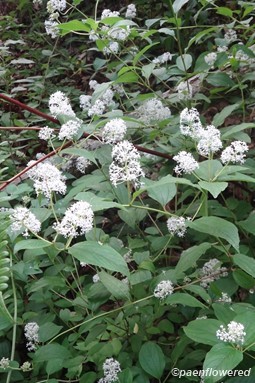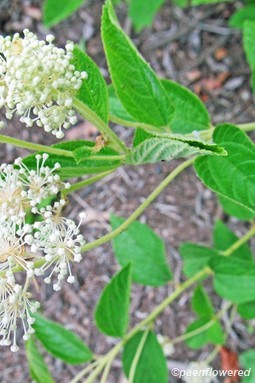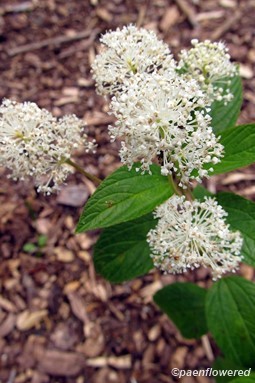Ceanothus americanus
A low-growing shrub with clusters of creamy-white flowers
Ceanothus americanus New Jersey tea
This native plant is a member of the buckthorn family. It grows in the form of a low shrub. Several woody branches grow vertically from a deep-reddish root. The stem is brownish-green or bronze in color.
The tiny flowers are in oval clusters that rise from the leaf axils on shoots that are new growth for the year. Each creamy-white flower is about ¼ inch wide. They have five petals, each of which narrows to a stalk-like base. The five stamens protrude from the flower. These flowers have a pleasant odor and attract butterflies and hummingbirds. The alternate ovate leaves are 1-3 inches long and have 3 veins, teeth and a sharp point. The fruit is a capsule that turns black when mature and splits into three 1-sided parts.
The plant grows 3-4 feet tall. It can be found in open woods, prairies, along roadsides and in clearings and tolerates sandy or dry soil. It is common in forest clearings and along banks of streams. It is found throughout much of eastern and central United States. It is reported in almost all Pennsylvania counties.
An excellent caffeine-free tea can be made from the dried leaves of this shrub. It was very popular during the Revolutionary War period in the United States as a substitute for imported tea. It is also known by the common names redroot, tea ceanotus and mountain sweet. The similar smaller redroot (C. herbaceous) has flowers in rounded clusters and has smaller leaves. Smaller redroot is also locally called red root or mountain sweet.
Native Americans used this plant for medicinal purposes and scientific studies have shown that it can affect the rate of blood clotting and has anti-microbial properties against mouth bacteria. The blooming period is early to mid-summer.
Habitat & Range
Grows on wooded bluffs, roadside banks, and shaly slopes.
Present throughout the state.
Wetland code: Not classified
Phenology
Flowers in summer.
Plant Codes
S-rank: No Rank
G-rank: G5 (Secure)






Comments
Have you spotted this plant in your area? We'd love to hear about your experience! Share your comments or questions about the plant below. Comments are moderated before posting.